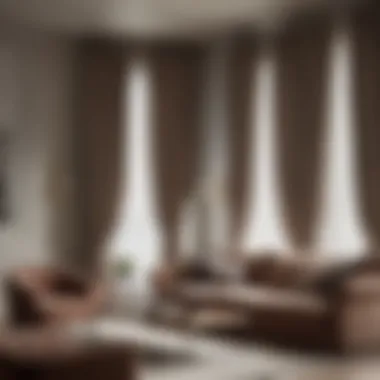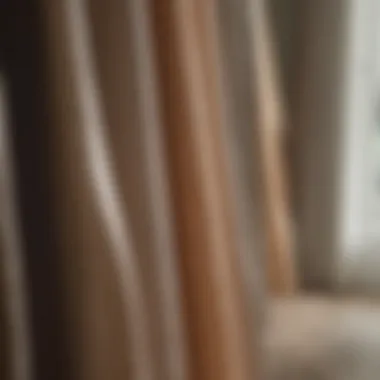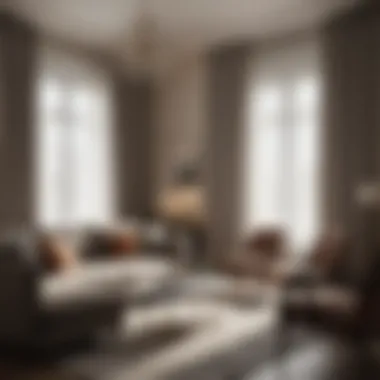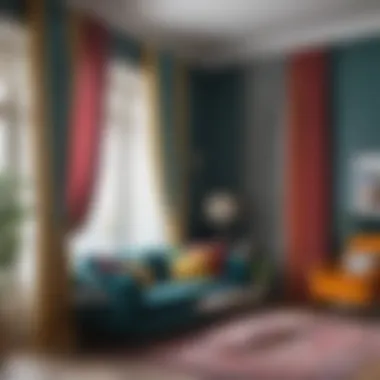The Importance of Solid Curtains in Living Room Design


Intro
Solid curtains serve a vital role in living rooms, often acting as more than just decorative accents. They contribute not only to the aesthetic charm but also to the functionality and comfort of the space. With the right fabric choices, these curtains can enhance room insulation, regulate light levels, and even influence mood and psychology. Homeowners and interior designers alike realize that these textiles are a key element in creating a harmonious, welcoming living environment.
Understanding how solid curtains fit into the broader scope of living room design requires consideration of various factors, including material selection, color psychology, insulation benefits, and proper maintenance. This guide provides insights that could be quite beneficial for anyone seeking to elevate their living spaces thoughtfully and purposefully.
Understanding Solid Curtains
Solid curtains are not just mere fabric hangings; they possess a unique ability to transform a living space. Their significance in living room design is multifaceted, addressing both practical and aesthetic needs. Homeowners and interior designers alike benefit from understanding what solid curtains can offer, as these fabrics can enhance privacy, provide light control, and add warmth to a room. By delving deeper into their characteristics, we can better appreciate their role in creating the right ambiance.
Defining Solid Curtains
Solid curtains, as the name suggests, are made from a single fabric color or a pattern lacking intricate designs. The simplicity these curtains provide brings a certain elegance to any room. While patterns may draw attention, solid curtains serve a different function—creating a backdrop that allows furniture and decor elements to shine. They can be bold in color or subtle, depending on the desired effect.
Historical Context
Historically, curtains have played an important role in homes. Going back to the Victorian era, draperies were used not just for decoration but also for practicality—providing warmth and privacy in homes without central heating. Solid curtains became particularly popular post-World War II as mass production made them accessible to the average person. In contemporary times, they have evolved to be essential in modern interior design, reflecting both personal taste and functional needs.
Common Materials Used
Different materials are used in the production of solid curtains, each contributing unique characteristics to their overall function and style.
Polyester
Polyester is a popular material choice for solid curtains. Known for its durability, it withstands fading and wrinkling, making it ideal for homeowners looking for low-maintenance options. The fabric also drapes well, creating a polished look. One unique feature of polyester is its ability to mimic more expensive fabrics without the hefty price tag. However, its synthetic nature can sometimes hinder breathability.
Cotton
Cotton is cherished for its softness and versatility. With its natural fibers, it offers a breathable option for those who might be more sensitive to synthetic materials. Cotton curtains can be easily washed, ensuring they maintain their fresh appearance. However, they might fade over time when exposed to direct sunlight, requiring some more care in placement and use.
Linen
Linen curtains bring a light, airy feel to any room. The texture is often valued in design, enhancing the tactile experience of a space. A key characteristic of linen is its natural luster, which can catch the light in stunning ways. However, it's worth noting that linen may wrinkle easily, which can be seen as a downside for some—yet others find it adds to the charm.
Wool
While less common, wool curtains have unique insulating properties. They are excellent at regulating temperature, making them a wise option for energy-conscious homeowners. The natural resilience of wool fibers also means they can stand the test of time better than many synthetic fabrics. However, wool can be heavier and more costly, which may limit its appeal in some styles of homes.
"Choosing the right curtain material is not just about aesthetics; it’s about enhancing the livability of your space."
In summary, curtains, particularly solid ones, are more than mere textile decorations. They provide functionality and artistic expression in targeted ways. The choice of materials like polyester, cotton, linen, and wool each brings forth its own advantages and potential setbacks, making the selection a crucial aspect of living room design. Understanding these factors allows one to curate a space that marries style with practicality.
Functional Benefits
When it comes to living room design, solid curtains play a pivotal role that goes beyond mere decoration. They are essential for providing functionality that significantly influences the comfort and aesthetics of a space. Understanding the functional benefits of solid curtains is vital for homeowners and designers alike, as it ensures a more harmonious and practical living environment. Below, we dive into the specific elements that underscore their importance.
Light Control
Reducing Glare
One of the key aspects of solid curtains is their ability to reduce glare. This quality becomes particularly beneficial in homes that experience bright sunlight during certain times of the day. By minimizing harsh light, solid curtains not only protect furniture and artwork from fading, but they also contribute to a more inviting atmosphere. This means you won't have to squint at your favorite book or strain to watch the television.
Furthermore, the material used in these curtains often determines their effectiveness. Thicker or darker fabrics are known to absorb more light, creating a cozy location within your living space. Thus, selecting a fabric that suits your needs is essential. Homeowners aiming for a calm environment find that reducing glare results in a more relaxed mood.


Creating Ambiance
In addition to managing light levels, solid curtains also excel at creating ambiance. Whether you’re looking to make a dramatic statement or establish a soothing retreat, the color and texture of curtains play a central role. For instance, deep hues can set a more sophisticated tone while lighter shades can evoke a breezy, airy feel.
The beauty of ambiance is its adaptability. With the manipulation of natural light through curtains, homeowners can effortlessly transition a space from day to night, which brings us to moods and occasions. Softly drawn curtains in the evening enhance intimacy, while fully opened curtains during the day invite warmth and cheer. Thus, the control of light through solid curtains serves both a practical and an aesthetic function.
Insulation Properties
Energy Efficiency
Another tremendous benefit of solid curtains is their contribution to energy efficiency. Their dense fabric can act as a thermal barrier, keeping your living area warmer in winter and cooler in summer. This helps in regulating the temperature, meaning your heating and cooling systems don't have to work as hard, resulting in lower energy bills.
Thinking about climate control, solid curtains can become your secret weapon. They block the sun during hot months while preventing heat loss in colder months. Thus, not only do you improve comfort levels, but you also play a small part in resource conservation.
Noise Reduction
Let’s not overlook the noise reduction capability of solid curtains. In urban environments or busy neighborhoods, the intrusion of outside noise can disrupt peace in your living room. The thicker the curtains, the better they absorb sound, creating a more serene atmosphere.
What’s appealing about this feature is its dual functionality: as a design element, solid curtains contribute to the style of a room while also silencing external disturbances. Homeowners may find solace in knowing that investing in quality curtains enhances their home’s personality and provides needed quietude.
Privacy Enhancement
Solid curtains provide an effective means of enhancing privacy in living spaces. With the ability to completely block out any view into your home, they can give you peace of mind, especially in densely populated areas where homes are close together.
There’s something to be said about the comfort that comes with snugly drawn curtains. They create not just a visual barrier, but also an emotional one, allowing you to unwind without the feeling of being watched. By incorporating solid curtains into your living room design, you've taken a substantial step towards ensuring both style and privacy.
Aesthetic Impact
When it comes to the overall design of a living room, the aesthetic impact of solid curtains cannot be overstated. These textiles serve as not just a functional element but also a core component that molds the space's visual narrative. By thoughtfully selecting solid curtains, homeowners can create an atmosphere that resonates with their personality and lifestyle.
Visual Cohesion: Solid curtains bring a sense of unity to a room. They can seamlessly tie together various design elements, from furniture to wall colors. Without curtains, a window might seem like an unfinished puzzle piece, but once dressed in solid fabrics, it becomes an integral part of the design story. The choice of curtain color can complement or contrast with the surrounding decor, enhancing the room's aesthetic appeal.
Focal Points: Depending on their color and texture, solid curtains can also establish a focal point in a living room. For instance, rich, deep hues can draw the eye, creating a dramatic impact, while lighter shades tend to evoke calmness and serenity. Homeowners can manipulate these effects by considering where they want the viewer’s gaze to land upon entering the space.
"Solid curtains offer not just aesthetic adornment but also a reflection of one’s style and preferences, accentuating the unique character of a living room."
Solid curtains aren't just about looks; they're also about the emotional response they trigger. A well-chosen fabric can evoke feelings ranging from warmth and comfort to cool elegance. This depth of perception significantly influences how we feel in a room.
Contribution to Interior Design
In the arena of interior design, solid curtains can be monumental. Their adaptability to various styles—from contemporary to traditional—makes them a mainstay in many homes. They unify the look of the room, providing a polished finish to any design scheme. Whether it's a bohemian loft or a minimalist setup, solid curtains can easily adapt, delivering a tailored finish.
The textures of the curtains also play a role in defining the room's character. A soft linen curtain in a light color can lend airy lightness, while dense velvet panels can bring a sense of luxury and sophistication. Therefore, selecting the right texture is as crucial as choosing the right color, as each fabric tells a different story.
Color Psychology
Colors have a profound psychological effect on us, impacting mood and perception. When selecting solid curtains for a living room, homeowners should be aware of how different shades can influence their space.
Warm Colors
Warm colors such as reds, oranges, and yellows can infuse energy into a space. This aspect makes them particularly beneficial in a living room, an area often designed for socializing and personal connection. A rich, burnt orange curtain, for example, can evoke feelings of warmth and cheer, drawing people in. However, while these colors can energize, they can sometimes feel overpowering if not balanced properly with softer hues or neutral tones.
The key characteristic of warm colors lies in their ability to stimulate conversation and interaction, making them popular choices for lively homes. But, if overdone, they might overwhelm the senses, hence the balance is the name of the game.


Cool Tones
On the flip side, cool tones—think blues, greens, and certain grays—are renowned for their calming effects. Incorporating cool-toned curtains can create a tranquil retreat within the living room. A soft, powdery blue curtain can enhance feelings of peace, making it an ideal choice for spaces intended for relaxation.
The unique feature of cool tones is their versatility; they can make a room feel more expansive and serene. However, too much coolness may cause a room to feel sterile if not tempered with warmer accents.
Pattern Versus Solid
The debate between pattern and solid curtains often boils down to individual preference and the specific ambiance one wishes to achieve. Solid curtains provide simplicity and allow for a cleaner, more cohesive look. On the other hand, patterned curtains can infuse character and playful complexity into a space.
Choosing between the two involves considering the existing decor and the effect desired. If the decor is already bold and busy, opting for solid curtains can create a visual respite and enhance overall balance. Conversely, if the room is minimalist, a vibrant patterned curtain can serve as an eye-catching accent, pulling together various design elements.
Ultimately, the choice between solid and patterned curtains influences not just the aesthetic, but the emotional atmosphere of the living room as well.
Choosing the Right Curtains
Choosing the right curtains transcends mere fabric selection; it's a fundamental process that can significantly influence the atmosphere and functionality of a living room. Curtains serve as both a practical and aesthetic element, and their proper selection allows for the right balance of light control, privacy, and style. They can elevate a room from drab to fab, or they can just as easily diminish the overall vibe of the space if not chosen carefully.
Evaluating Fabric Options
The texture and composition of curtains can have a profound impact on their performance and aesthetic. Various fabric options each have their own characteristics, and here's how to navigate this terrain:
- Polyester: Known for its durability, polyester curtains resist wrinkles and fading. They're ideal for high-traffic areas where maintenance is a concern.
- Cotton: This fabric provides a soft feel and pleasant drape. It's great for layering with other textiles, giving you loads of options for styling. However, be mindful that cotton can shrink and fade over time, especially if it sees a lot of sunlight.
- Linen: Linen curtains exude a breezy charm, perfect for enhancing a casual living environment. They tend to have a looser weave, making them less effective at blocking light. Therefore, consider linen if you prioritize a soft, diffused light.
- Wool: Often overlooked, wool curtains offer excellent insulation properties. While they may not boast the variety of colors and patterns found in other fabrics, their performance makes a compelling case for consideration.
Understanding each fabric's quirks and benefits helps avoid costly missteps. Simple trials or swatch samples can provide a hands-on opportunity to gauge how each fabric type feels and behaves in your space.
Measuring for Curtains
Nothing makes your living room feel off quite like ill-fitting curtains. Accurate measurements are crucial for achieving that polished look. Here’s how to go about it:
- Window Width: Measure the width of your window frame. For a fuller look, add another 12-24 inches to each side. This allows the curtains to stack back nicely, letting in maximum light when drawn open.
- Window Height: Decide where you want the curtain to hang. A common rule is to mount the rod 4-6 inches above the window frame. This not only enhances the visual height of your room but also helps to elongate the appearance of the windows.
- Length Options: Choose between floor-length, sill-length, or a mid-length option based on your living room's decor. Floor-length curtains create an elegant, cascading look, while sill-length drapes work well in more casual spaces or if you have furniture close to the window.
"The right measurements can distinguish between a cohesive look and a disjointed appearance. It’s that simple."
Selecting a Color Palette
The color of your curtains can shape the ambiance of the living room, effectively setting the mood. Consider the following:
- Harmony with Existing Decor: Look at the colors already present in your furniture, walls, and accessories. Your curtains should complement, not compete.
- Neutral Shades: If you're unsure, opting for neutral colors can serve as a versatile backdrop. Think shades of gray, beige, or soft whites that can adapt over time as your decor evolves.
- Bold Hues: For those looking to make a statement, bold colors can add dynamic energy or contrast, drawing the eye and providing a focal point within the room.
- Patterns and Textures: Consider how patterns can play with the light and feel of the space. Stripes, plaids, or florals can introduce movement and flair but may also require balancing with solids elsewhere in the room.
The choice of color reflects not only personal taste but also psychological impacts; colors can evoke feelings of calm, excitement, or warmth, influencing how the space feels and functions.
In summary, the quest for the right curtains in your living room brings together considerations of fabric, measurements, and color. Each step requires careful thought to ensure that you not only enhance your space but also reflect your unique style.
Installation Considerations
Understanding how to properly install solid curtains is crucial for their functionality and longevity. Thoughtful installation can help achieve aesthetic harmony, light control, and effective insulation in your living room. It’s about more than just hanging fabric on a rod; it encompasses hardware selection, the choice between DIY or hiring professionals, and regular maintenance to keep the curtains looking their best.
Hardware Requirements
Before one gets into the thick of installing solid curtains, it’s important to consider the hardware. Choosing the right mounting system can make or break the aesthetic and functionality of the curtains. There are several hardware options that can be considered:
- Curtain Rods: These come in various styles, from traditional wooden rods to modern metallic ones. Select one that matches your living room decor while ensuring it can support the weight of the curtains.
- Brackets: The brackets you choose will determine how far the curtain hangs from the wall. Ensure they are sturdy and can handle the stress of the solid curtains.
- Rings or Clip Hooks: These add an extra touch to the design and allow for easier sliding of the curtains across the rod.


Iterating carefully over these requirements ensures that everything is set for an elegant display of your solid curtains.
DIY vs. Professional Installation
Now, for many homeowners, the question arises: should you tackle this as a DIY project or bring in the pros? The answer depends on several factors like your comfort level with tools and the complexity of the installation.
- DIY Installation: If you’re handy and possess basic tools, installing solid curtains can be a fulfilling project. There’s a sense of pride that comes from creating a cozy space with your own efforts, and you could save a few bucks in the process.
- Professional Installation: On the flip side, enlisting a professional can relieve you of the stress and guesswork. This option ensures that the curtains are hung perfectly level and secure, eliminating any risk of falling—a comforting thought for those with children or pets!
Ultimately, factor in your schedule and the installation complexity when making your decision.
Maintenance and Care Tips
Keeping your solid curtains clean and maintained enhances their longevity and keeps your space looking fresh. Dust and debris can accumulate over time, and knowing how to handle this can make a world of difference.
Cleaning Techniques
When it comes to cleaning solid curtains, understanding fabric care is essential. Each material has its own demands:
- Machine Washable: For polyester or cotton curtains, a gentle machine wash can keep them looking sharp. Always check the label before tossing them in.
- Dry Cleaning: For more delicate fabrics, like linen and wool, professional dry cleaning is often the better choice. This method protects the texture and color.
- Spot Cleaning: If an accidental spill occurs, addressing it right away with a damp cloth is a smart move. This helps prevent it from setting in and helps maintain that fresh look.
Selecting the right cleaning method is a beneficial measure for sustaining overall cleanliness and maximizing the functional benefits of solid curtains.
Longevity Tips
Ensuring your curtains don’t just hang there for a while but continue to serve you for years to come relies heavily on how well you maintain them. Here are a few tips:
- Rotate Them: If your curtains are often closed, consider rotating them regularly to ensure even wear.
- Limit Sunlight Exposure: Continuous, direct sunlight can fade colors over time. When you can, draw your curtains during peak hours of sunlight.
- Regular Dusting: Utilize a vacuum with an upholstery attachment or a gentle duster to regularly remove dust from the fabric. This small effort can delay the need for a more thorough clean.
Taking such steps results in not just maintaining the appearance, but prolonging the lifespan of solid curtains and protecting your investment.
In a nutshell, a little attention to installation and maintenance can go a long way. From choosing the right hardware to deciding how and when to clean your curtains, these considerations pave the way for an enhanced living environment.
Innovative Trends
As the world of interior decor evolves, solid curtains are no exception. In a time where technology and sustainability play pivotal roles in design, innovative trends in solid curtains are transforming the way homeowners and designers think about this essential element. Understanding these trends not only heightens one's appreciation for curtains but also informs better choices for modern living spaces.
Smart Curtain Technology
The advent of smart home technology has spilled over into the realm of solid curtains. Smart curtain systems allow users to control their window treatments with the tap of a finger or even via voice command. Imagine adjusting the curtains based on the sunlight filtering into your living room. This is no longer a luxury but a practical solution that enhances comfort and energy efficiency.
Smart curtains often come with integrated sensors that can detect light levels and adjust automatically throughout the day. So, whether it’s to block out the harsh midday sun or to let in the gentle evening glow, these curtains adapt to the needs of the moment.
In addition to convenience, smart technology can help gray out unwanted outside noise, particularly in busy urban environments. With features like timer settings, one has the ability to set a schedule for opening and closing curtains—perfect for when you're away from home.
Sustainable Materials
As environmental awareness grows, so does the shift towards sustainable materials in home decor. Using curtains made from organic cotton, bamboo, or recycled polyester not only benefits the planet but can also enhance indoor air quality. Many manufacturers are now focusing on sourcing materials that have a lower environmental impact, which resonates well with conscientious consumers.
Moreover, sustainable curtains often come without harsh chemicals found in traditional fabric treatments. For homeowners, this means a healthier living space without compromising aesthetic appeal. You might choose earthy colors or textures, fostering a deeper connection with nature.
Choosing sustainable curtains also aligns with broader trends toward minimalism and simplicity in design. They serve as a subtle reminder that beauty can exist with environmental responsibility.
Customizable Options
Personalization is king in today’s decor choices, and solid curtains are no exception. Customizable options allow individuals to tailor their curtains according to personal taste and room design, making a house feel more like a home. From selecting fabrics to choosing specific lengths, homeowners have the autonomy to create a unique look.
Many brands now offer online tools that allow for virtual visualization of how different styles and colors will look in a given space. This technology can aid in making informed decisions, ensuring that the chosen curtains fit seamlessly into the existing decor.
Additionally, customizable curtains can cater to various needs—be it blackout materials for bedrooms or sheer fabrics allowing for soft diffused light in living areas. No matter the preference, the ability to customize ensures that each set of curtains is a perfect fit for the lifestyle and aesthetic choices of the owner.
"Innovative curtain solutions transform not just the look of your living space but also the way in which you interact with your home environment."



